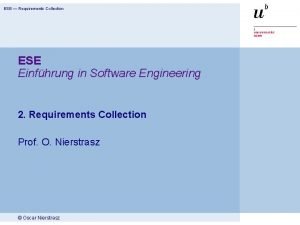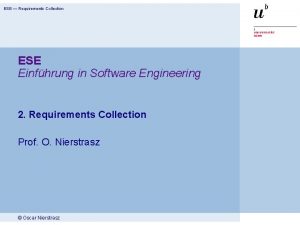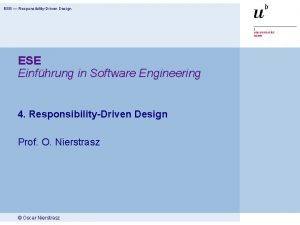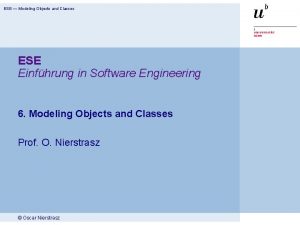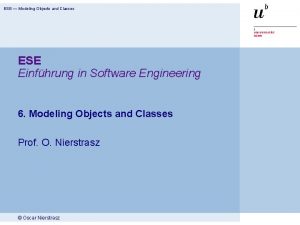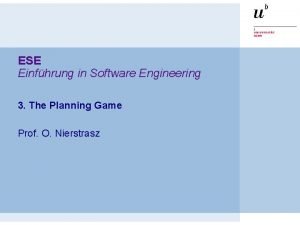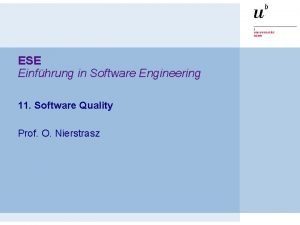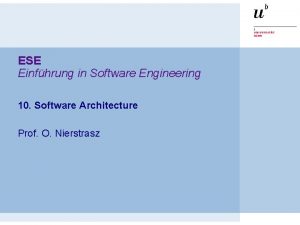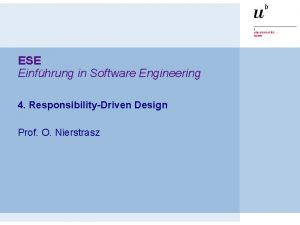ESE The Planning Game ESE Einfhrung in Software






































- Slides: 38

ESE — The Planning Game ESE Einführung in Software Engineering 3. The Planning Game Prof. O. Nierstrasz © Oscar Nierstrasz

ESE — The Planning Game Roadmap > XP — coping with change and uncertainty > Customers and Developers — why do we plan? > The Planning Game — Exploration — User stories — Estimation — Commitment — Steering > Iteration © Oscar Nierstrasz Based on a presentation by Matthias Rieger. 2

ESE — The Planning Game Sources > e. Xtreme Programming Explained: Embrace Change. Kent Beck. Addison-Wesley Pub Co; ISBN: 0201616416; 1 st edition (October 5, 1999) > www. extremeprogramming. org © Oscar Nierstrasz 3

ESE — The Planning Game Roadmap > XP — coping with change and uncertainty > Customers and Developers — why do we plan? > The Planning Game — Exploration — User stories — Estimation — Commitment — Steering > Iteration © Oscar Nierstrasz 4

ESE — The Planning Game Extreme Programming Product Planning Game Simple Design XP is a set of mutually supportive Process System practices for developing quality Metaphor Teamwork Continuous Integration software Testing Refactoring Coding Pair programming Collective Code Ownership 40 Hour Week On-Site Customer © Joseph Pelrine © Oscar Nierstrasz Coding Standards Small Releases See also: www. extremeprogramming. org 5

ESE — The Planning Game Extreme Programming http: //en. wikipedia. org/wiki/Fair_use © Oscar Nierstrasz 6

ESE — The Planning Game Driving Metaphor > Driving a car is not about pointing the car in one direction and holding to it; driving is about making lots of little course corrections. “Do the simplest thing that could possibly work” © Oscar Nierstrasz 7

ESE — The Planning Game Roadmap > XP — coping with change and uncertainty > Customers and Developers — why do we plan? > The Planning Game — Exploration — User stories — Estimation — Commitment — Steering > Iteration © Oscar Nierstrasz 8

ESE — The Planning Game Why we plan We want to ensure that > we are always working on the most important things > we are coordinated with other people > when unexpected events occur, we understand the consequences on priorities and coordination Plans must be > easy to make and update > understandable by everyone that uses them © Oscar Nierstrasz 9

ESE — The Planning Game The Planning Trap Plans project a likely course of events — Plans must try to create visibility: where is the project But: A plan does not mean you are in control of things — Events happen — Plans become invalid Having a plan isn’t everything, planning is. — Keep plans honest and expect them to always change © Oscar Nierstrasz 10

ESE — The Planning Game Customer-Developer Relationships A well-known experience in Software Development: The customer and the developer sit in a small boat in the ocean and are afraid of each other. Customer fears Developer fears They won't get what they asked for They won't be given clear definitions of what needs to be done They must surrender the control of their careers to techies who don't care They will be given responsibility without authority They'll pay too much for too little They will be told to do things that don't make sense They won't know what is going on (the They'll have to sacrifice quality for plans they see will be fairy tales) deadlines Result: A lot of energy goes into protective measures and politics instead of success © Oscar Nierstrasz 11

ESE — The Planning Game The Customer Bill of Rights You have the right to an overall plan To steer a project, you need to know what can be accomplished within time and budget You have the right to get the most The most valuable things are possible value out of every programming worked on first. week You have the right to see progress in a running system. You have the right to change your mind, to substitute functionality and to change priorities without exorbitant costs. Only a running system can give exact information about project state Market and business requirements change. We have to allow change. You have the right to be informed about schedule changes, in time to choose how XP works to be sure everyone to reduce the scope to restore the original knows just what is really happening. date. © Oscar Nierstrasz 12

ESE — The Planning Game The Developer Bill of Rights You have the right to know what is needed, with clear declarations of priority. Tight communication with the customer. Customer directs by value. You have the right to produce quality Unit Tests and Refactoring help work all the time. to keep the code clean You have the right to ask for and receive help from peers, managers, and customers You have the right to make and update your own estimates. You have the right to accept your responsibilities instead having them assigned to you © Oscar Nierstrasz No one can ever refuse help to a team member Programmers know best how long it is going to take them We work most effectively when we have accepted our responsibilities instead of having them thrust upon us 13

ESE — The Planning Game Separation of Roles Customer makes business decisions Developers make technical decisions Business Decisions Scope Dates of the releases Priority Technical Decisions Estimates Dates within an iteration Team velocity Warnings about technical risks The Customer owns “what you get” while the Developers own “what it costs”. © Oscar Nierstrasz 14

ESE — The Planning Game Roadmap > XP — coping with change and uncertainty > Customers and Developers — why do we plan? > The Planning Game — Exploration — User stories — Estimation — Commitment — Steering > Iteration © Oscar Nierstrasz 15

ESE — The Planning Game A game with a set of rules that ensures that Customer and Developers don’t become mortal enemies Goal: — Maximize the value of the software produced by Developers. Overview: 1. Release Planning: Customer selects the scope of the next release 2. Iteration Planning: Developers decide on what to do and in which order © Oscar Nierstrasz 16

ESE — The Planning Game The Release Planning Game Customer Developers Write Story Exploration Phase Estimate Story Split Story Sort Stories by Value Sort Stories by Risk Commitment Phase Set Velocity Choose Scope Iteration Steering Phase Recovery New Story © Oscar Nierstrasz Reestimate 17

ESE — The Planning Game Roadmap > XP — coping with change and uncertainty > Customers and Developers — why do we plan? > The Planning Game — Exploration — User stories — Estimation — Commitment — Steering > Iteration © Oscar Nierstrasz 18

ESE — The Planning Game User Stories http: //en. wikipedia. org/wiki/Fair_use © Oscar Nierstrasz 19

ESE — The Planning Game: Exploration Phase Purpose: Get an appreciation for what the system should eventually do. The Moves: — Customer: Write a story. Discuss it until everybody understands it. — Developers: Estimate a story in terms of effort. — Customer: Split a story, if Developers don’t understand or can’t estimate it. — Developers: Do a spike solution to enable estimation. — Customer: Toss stories that are no longer wanted or are covered by a split story. © Oscar Nierstrasz 20

ESE — The Planning Game User Stories Principles of good stories: > Customers write stories. — Developers do not write stories. > Stories must be understandable to the customer > The shorter the better. No detailed specification! — Write stories on index cards > Each story must provide something of value to the customer > A story must be testable — then we can know when it is done © Oscar Nierstrasz Writing stories is an iterative process, requiring interaction between Customer and Developers. 21

ESE — The Planning Game Stories A story contains: > a name > the story itself > an estimate Example: — When the GPS has contact with two or fewer satellites for more than 60 seconds, it should display the message “Poor satellite contact”, and wait for confirmation from the user. If contact improves before confirmation, clear the message automatically. © Oscar Nierstrasz 22

ESE — The Planning Game Splitting Stories Developers ask the Customer to split a story if > They cannot estimate a story because of its complexity > Their estimate is longer than two or three weeks of effort Why? > Estimates get fuzzy for bigger stories > The smaller the story, the better the control (tight feedback loop) © Oscar Nierstrasz 23

ESE — The Planning Game Roadmap > XP — coping with change and uncertainty > Customers and Developers — why do we plan? > The Planning Game — Exploration — User stories — Estimation — Commitment — Steering > Iteration © Oscar Nierstrasz 24

ESE — The Planning Game Initial Estimation of Stories With no history, the first plan is the hardest and least accurate (fortunately, you only have to do it once) How to start estimating: — Begin with the stories that you feel the most comfortable estimating. — Intuitively imagine how long it will take you. — Base other estimates on the comparison with those first stories. Spike Solutions: — Do a quick implementation of the whole story. — Do not look for the perfect solution! — Just try to find out how long something takes © Oscar Nierstrasz 25

ESE — The Planning Game Estimating Stories Keys to effective story estimation: > Keep it simple > Use what happened in the past (“Yesterday’s weather”) > Learn from experience Comparative story estimation: > One story is often an elaboration of a closely related one > Look for stories that have already been implemented > Compare difficulties, not implementation time — “twice as difficult”, “half as difficult” > Discuss estimates in the team. Try to find an agreement. > “Optimism wins”: Choose the more optimistic of two disagreeing estimates. © Oscar Nierstrasz 26

ESE — The Planning Game Roadmap > XP — coping with change and uncertainty > Customers and Developers — why do we plan? > The Planning Game — Exploration — User stories — Estimation — Commitment — Steering > Iteration © Oscar Nierstrasz 27

ESE — The Planning Game: Commitment Phase Purpose: > Customer: to choose scope and date of next delivery > Developers: to confidently commit to deliver the next release The Moves: > Customer: Sort by stories by value • • • — Stories without which the system will not function Less essential stories, but still providing significant business value Nice-to-have stories Customer wants the release to be as valuable as possible © Oscar Nierstrasz 28

ESE — The Planning Game Commitment Phase … > Developers: Sort stories by risk 1. 2. 3. — > Stories that can be estimated precisely (low risk) Stories that can be estimated reasonably well Stories that cannot be estimated (high risk) Developers want to tackle high-risk first, or at least make risk visible Developers: Set team velocity How much ideal engineering time per calendar month/week can the team offer? — this is the budget that is available to Customer > Customer: Choose scope of the release, by either 1. 2. fixing the date and choosing stories based on estimates and velocity fixing the stories and calculating the delivery date © Oscar Nierstrasz 29

ESE — The Planning Game Roadmap > XP — coping with change and uncertainty > Customers and Developers — why do we plan? > The Planning Game — Exploration — User stories — Estimation — Commitment — Steering > Iteration © Oscar Nierstrasz 30

ESE — The Planning Game: Steering Phase Purpose: Update the plan based on what is learned. The Moves: > Iteration: Customer picks one iteration worth of the most valuable stories. — see Iteration Planning > Get stories done: Customer should only accept stories that are 100% done. > Recovery: Developers realize velocity is wrong — Developers re-estimate velocity. — Customer can defer (or split) stories to maintain release date. © Oscar Nierstrasz 31

ESE — The Planning Game: Steering Phase. . . > New Story: Customer identifies new, more valuable stories — Developers estimate story — Customer removes estimated points from incomplete part of existing plan, and inserts the new story. > Reestimate: Developers feel that plan is no longer accurate — Developers re-estimate velocity and all stories. — Customer sets new scope plan. © Oscar Nierstrasz 32

ESE — The Planning Game Roadmap > XP — coping with change and uncertainty > Customers and Developers — why do we plan? > The Planning Game — Exploration — User stories — Estimation — Commitment — Steering > Iteration © Oscar Nierstrasz 33

ESE — The Planning Game Iteration Planning © Oscar Nierstrasz 34

ESE — The Planning Game Iteration Planning > Customer selects stories to be implemented in this iteration. > Customer explains the stories in detail to the Developers — Resolve ambiguities and unclear parts in discussion > Developers brainstorm engineering tasks — A task is small enough that everybody fully understands it and can estimate it. — Use short CRC or UML sessions to determine how a story is accomplished. — Observing the design process builds common knowledge and confidence throughout the team > Developers /pairs sign up for work and estimates — Assignments are not forced upon anybody (Principle of Accepted Responsibility) — The person responsible for a task gets to do the estimate © Oscar Nierstrasz 35

ESE — The Planning Game What you should know! > Why is planning more important than having a plan? > Why shouldn’t Customers make technical decisions? > > Why shouldn’t Developers make business decisions? Why should stories be written on index cards? Why should the Customer sort stories by value? Why should the Developer sort stories by risk? How do you assign stories to Developers? © Oscar Nierstrasz 36

ESE — The Planning Game Can you answer the following questions? > What is “extreme” about XP? > What is the differences between a User Story and a Use Case? > Are Developers allowed to write stories? > What is the ideal time period for one iteration? > How can you improve your skill at estimating stories? © Oscar Nierstrasz 37

ESE — The Planning Game License > http: //creativecommons. org/licenses/by-sa/2. 5/ Attribution-Share. Alike 2. 5 You are free: • to copy, distribute, display, and perform the work • to make derivative works • to make commercial use of the work Under the following conditions: Attribution. You must attribute the work in the manner specified by the author or licensor. Share Alike. If you alter, transform, or build upon this work, you may distribute the resulting work only under a license identical to this one. • For any reuse or distribution, you must make clear to others the license terms of this work. • Any of these conditions can be waived if you get permission from the copyright holder. Your fair use and other rights are in no way affected by the above. © Oscar Nierstrasz 38
 Hình ảnh bộ gõ cơ thể búng tay
Hình ảnh bộ gõ cơ thể búng tay Frameset trong html5
Frameset trong html5 Bổ thể
Bổ thể Tỉ lệ cơ thể trẻ em
Tỉ lệ cơ thể trẻ em Voi kéo gỗ như thế nào
Voi kéo gỗ như thế nào Tư thế worms-breton
Tư thế worms-breton Hát lên người ơi
Hát lên người ơi Các môn thể thao bắt đầu bằng tiếng chạy
Các môn thể thao bắt đầu bằng tiếng chạy Thế nào là hệ số cao nhất
Thế nào là hệ số cao nhất Các châu lục và đại dương trên thế giới
Các châu lục và đại dương trên thế giới Công của trọng lực
Công của trọng lực Trời xanh đây là của chúng ta thể thơ
Trời xanh đây là của chúng ta thể thơ Mật thư tọa độ 5x5
Mật thư tọa độ 5x5 Phép trừ bù
Phép trừ bù Phản ứng thế ankan
Phản ứng thế ankan Các châu lục và đại dương trên thế giới
Các châu lục và đại dương trên thế giới Thể thơ truyền thống
Thể thơ truyền thống Quá trình desamine hóa có thể tạo ra
Quá trình desamine hóa có thể tạo ra Một số thể thơ truyền thống
Một số thể thơ truyền thống Bàn tay mà dây bẩn
Bàn tay mà dây bẩn Vẽ hình chiếu vuông góc của vật thể sau
Vẽ hình chiếu vuông góc của vật thể sau Thế nào là sự mỏi cơ
Thế nào là sự mỏi cơ đặc điểm cơ thể của người tối cổ
đặc điểm cơ thể của người tối cổ Thế nào là giọng cùng tên? *
Thế nào là giọng cùng tên? * Vẽ hình chiếu đứng bằng cạnh của vật thể
Vẽ hình chiếu đứng bằng cạnh của vật thể Fecboak
Fecboak Thẻ vin
Thẻ vin đại từ thay thế
đại từ thay thế điện thế nghỉ
điện thế nghỉ Tư thế ngồi viết
Tư thế ngồi viết Diễn thế sinh thái là
Diễn thế sinh thái là Dạng đột biến một nhiễm là
Dạng đột biến một nhiễm là Các số nguyên tố
Các số nguyên tố Tư thế ngồi viết
Tư thế ngồi viết Lời thề hippocrates
Lời thề hippocrates Thiếu nhi thế giới liên hoan
Thiếu nhi thế giới liên hoan ưu thế lai là gì
ưu thế lai là gì Khi nào hổ con có thể sống độc lập
Khi nào hổ con có thể sống độc lập Khi nào hổ con có thể sống độc lập
Khi nào hổ con có thể sống độc lập













































